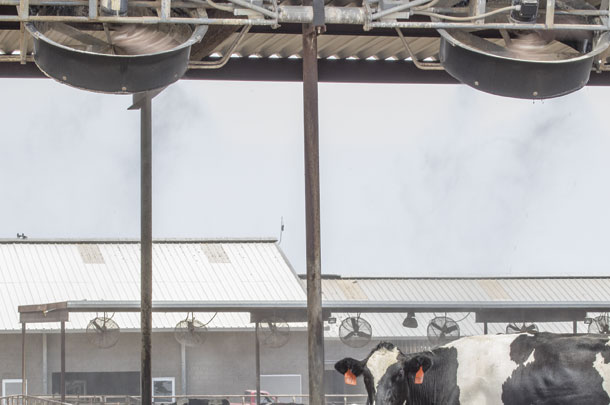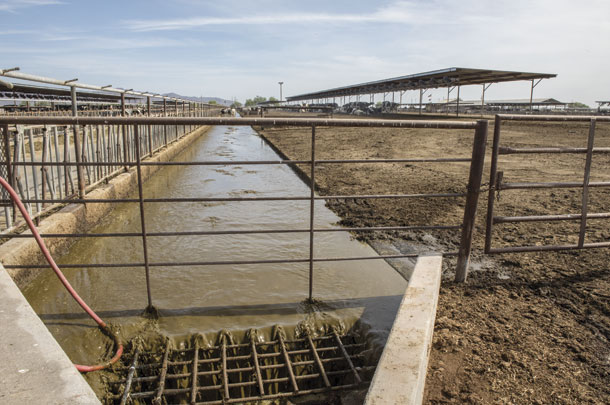There’s no shortage of sunshine in Buckeye, Arizona, where average highs hit over 100ºF during the summer. Keeping cows cool in this desert climate is no doubt a challenge, but dairyman Nick Vanderwey thinks outside the box to get the job done.
Over the last five years, Grand View Dairy has incrementally upgraded the cooling system to include automated, rotating fans that “flip” 180 degrees, providing directional relief from the detrimental effects of extreme heat for more than 6,000 cows among three sites.
The setup includes prefabricated bays of three 36-inch high-velocity fans with misters programmed to change directions based on factors like time of day, temperature, humidity and wind speed.
“With just the bump in milk, improved breeding and less maintenance, it pays for itself,” Vanderwey says.
The fans, combined with other abatement strategies, level out the summer milk production slump previously experienced. “We saw an improvement in milk. It flattened out our dips significantly,” Vanderwey says, noting a 4 percent increase in milk during the hot months of August, September and October compared to the previous panel-fan cooling array.
He observes reproduction benefits to boot, with cows achieving successful pregnancies throughout the season when conception rates historically struggled. “We are now able to breed practically year-round,” he adds. “That’s where the improvement comes in.”
Vanderwey also sees cost savings in the long term because the system requires fewer repairs and less time to install. “We were faced with the choice to keep buying and installing panel fans and have the maintenance guys do that in-house [including the plumbing and wiring], but that wouldn’t improve the overall system,” he says. “So we bit the bullet and made the capital investment and freed up the manpower.”
Stepping outside the box
Box-shaped panel fans were the industry standard when Vanderwey and his three brothers built their first drylot dairy in 1998. “It was panel fans or nothing,” Vanderwey recalls.
The brothers chose the familiar fan style again for the second dairy they built a few years later and maximized the cooling impact by spacing fans every 8 feet, 4 inches versus every 10 feet. However, Vanderwey recognized the downfall of fans fixed in place: They failed to deliver constant and consistent reprieve when cows most needed it.
During certain times of day, he even observed cows choosing to lie out in the sun with the fans and mist on them because it relieved more heat than being under the shade and fans.
“That was the limitation with the panel fans,” he says. “You could not get direct cooling on the cows during all times of the day.”
A damaging weather event provided the prompting to try something different. After a summer windstorm took out a couple of shades, Vanderwey seized the opportunity to “start fresh” on two corrals by installing the flip-style fans.

Happy with their performance, he gradually converted the remaining milk cow corrals at the two main sites. The dairy’s third site features a combination of flip fans and oscillating fans in a Saudi-style barn.
In synch with the sun
Vanderwey points out one of the greatest advantages of the flip fan is the programmable system that automatically adjusts fan and mister direction throughout the day based on shadow position. This means cows always have the option to seek the trifecta of shade, cooling and misting.
“The fans follow the sun,” Vanderwey says. “Now, no matter what time of the day, they are pointing the right way.”
In the face of the morning sun, the fans point toward the west as the sun rises in the east. They then rotate in line with the afternoon shade. By sundown, the fans blow to the east.
Not only does this provide effective cooling and shade throughout the day, but it also helps with managing beds. In the former setup, where fans and misters were fixed in a single direction, cows spent the majority of their day congregated in one area of the corral. The concentrated water and manure in these high-traffic areas turned into a “muddy mess.”
“Now, we are spreading the manure around and letting it dry,” Vanderwey says. “You can put cows where you want them, when you want them.”
In turn, he sees benefits in somatic cell count and milking efficiency. “The cows are cleaner, and that shows up in better milk quality,” Vanderwey says. “And milkers don’t have to spend as much time cleaning the cows because they come in with nice, clean udders.”
Taking the technology a step further, he also uses the fans to dry out the beds while the cows are away at the parlor and between 3 a.m. and 6 a.m. “I turn the mist off and aim the fans down and sweep every few minutes,” he explains. “Just by blowing the dry air down on the beds, it dries them out without scraping them.”
The fans are wired to a control cabinet with a programmable logic controller that connects wirelessly, allowing Vanderwey to make adjustments to his customized settings from his desk computer or iPad. “Once you figure out what works best for your dairy, you might make a few changes during the season, but then it pretty much runs itself,” he says.
Other cooling efforts
The flip fans complement other heat abatement methods at Grand View Dairy. Prior to entering the parlor, cows are given a good cool-down in the wash pen with a spray of water underneath to clean their udders as well as on their backs.
“This helps cool that core body temperature and provides an immediate effect,” Vanderwey says.
The group then moves to a drip pen to cool off and dry before entering the milking stalls. Fans continue cooling cows during milking, and when they return to the pen, a soaker line located above the mangers saturates cows as they belly up to the feedbunk. The soakers cycle on and off to provide evaporative cooling. Any water used for soaking that does not evaporate is collected and used to irrigate crops.

Cow comfort speaks for itself
While Vanderwey is satisfied by the improvements in milk production and reproduction that show up on paper, he is most pleased with what he observes out in the pens. Cow behavior says it all.
“When you drive through, and just about all the cows are lying down out of 250 animals in a pen, it tells me this is working and cows are comfortable,” Vanderwey concludes. “If they are lying down chewing their cud, it tells me, ‘You got it.’” ![]()
PHOTO 1: The flip-fan cooling system includes 0.75-horsepower fans, replacing the 0.5-horsepower panel fans previously used. “It allows us to put more water out and point the mist farther,” Nick Vanderwey says. “So power and water use has gone up – but so has milk production.”
PHOTO 2: Vanderwey programs the fan position and makes necessary adjustments from his iPad, like pointing them down when high winds pick up. “In the past, a big wind storm could take out panel fans because it would over-spin the motor, but with these, they are not spinning at hyper speed when the wind blows through them, and that should improve their life,” he says.
PHOTO 3: Along the feedbunk, water from the soaking system is collected and used to irrigate crops. Photos by Mike Dixon.

-
Peggy Coffeen
- Editor
- Progressive Dairyman
- Email Peggy Coffeen






